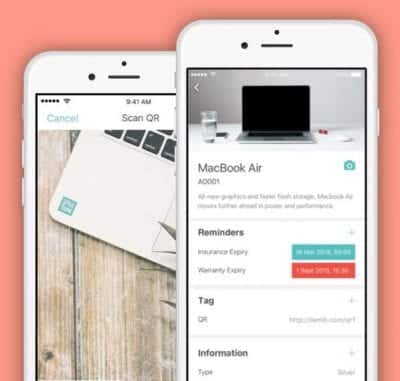A fixed asset register can provide you and your business with many benefits. Not only can you cut down on costs but also improve your time management and efficiency.
Ultimately, you’ll be able to make data-based decisions which benefit you in terms of insurance, reducing asset downtime, reducing lost or misplaced assets, and increasing the amount of time your employees can work with a fixed asset.

What is a Fixed Asset Register?
A fixed asset register is where all of your fixed assets are logged, tracked, and monitored.
Fixed assets will exist on your fixed asset register in a digital form. This means that any changes to the physical asset can be logged and updated in your fixed asset register software.
The way to link your physical asset to its digital profile is by using asset tags. There’s a range of different tags you can use, but QR code asset tags will be the fastest and cheapest in most circumstances.
Effectively, you scan the asset’s tag and then update the change in your fixed asset tracking software. Every time you scan the asset label, its last-seen location will also update in real-time.
How to Create a Fixed Asset Register
The steps to creating a fixed asset register are quick and simple. First, you’ll need to download your fixed asset tracking software onto your mobile, or access it via the web portal, then you can commence the steps towards a full fixed asset register.
1. Record all fixed assets
You may already have a register of your fixed assets in the form of a spreadsheet. If you don’t, that’s fine, but the first step is to record all of your fixed assets into your fixed asset tracking software.
Helpful features such as cloning and templates will streamline this process, but if you have an existing fixed asset register, an import service will also be possible.
2. Add information
When you’ve created your fixed asset register in your system, the next step is to add all relevant information against your assets.
This can be information such as purchase dates, depreciation information, warranties, and so on.
You’ll also be able to add your fixed assets to hierarchical locations if they move frequently, then run a report on how long an asset has been in that location. In other words, if an asset moves between two rooms frequently, it can be logged as such.
This is where you’ll want to test out the full functionality of your fixed asset register system. The information you add will inform your fixed asset tracking, so checking if there are features such as bookings, maintenance, and reminders will be hugely helpful.
3. Fixed asset tagging
The next step is fixed asset tagging. This is where you link your fixed assets to their digital profiles.
Using QR code asset tags as an example, the process will be to stick QR code asset tags onto your assets, open their digital profile, and add the QR code by scanning it.
Now, every subsequent time you scan the QR code from your app’s in-built scanner, it’ll open the corresponding digital profile.
Barcode tagging works in the same way, and RFID tagging differs as external hardware is required to scan your RFID tags. Find out more about the benefits and drawbacks of QR and RFID.

4. Monitor your assets
The next step is monitoring your assets and scaling your fixed asset tracking system.
Every time an asset requires maintenance, scanning the asset’s tag and logging this is what creates that asset’s history. So, the more you track, the more you monitor, and the more you update, the more accountability you get.
The benefit is that with fixed asset tagging, updating asset information is almost instant, meaning you save time across the board while also saving money.
A job shared is a job halved, too, so scaling your fixed asset tracking further increases your accountability while minimising the time you spend in your fixed asset tracking software.
What you get out of itemit’s Fixed Asset Register Software
itemit’s fixed asset register software gives you a complete suite of features to monitor, track, and manage your assets.
Use itemit’s bespoke issues management system to track reactive maintenance and use our reminders feature to track repeat or pre-emptive maintenance, such as PAT tests.
You can book assets and check them in and out, as well as track them in hierarchical locations. You can also add any attachments, images, and comments you may need, giving you full control over your fixed asset management.
To find out more, you can contact us at team@itemit.com, on +44 1223 421611. We’ll get you set up in no time!
Create Your Fixed Asset Register Today
Start your free 14-day trial now
Instant access. No credit card details required.


